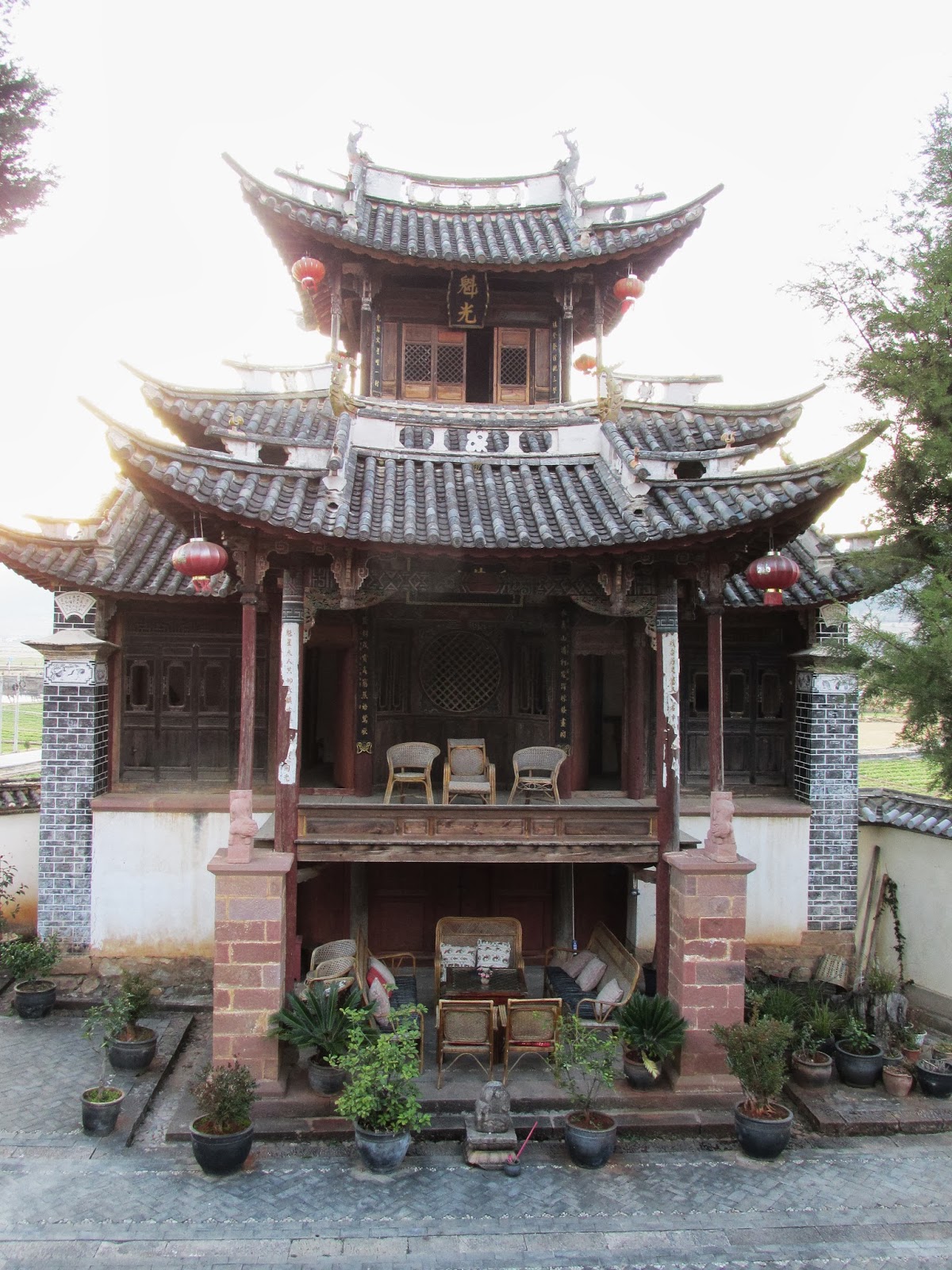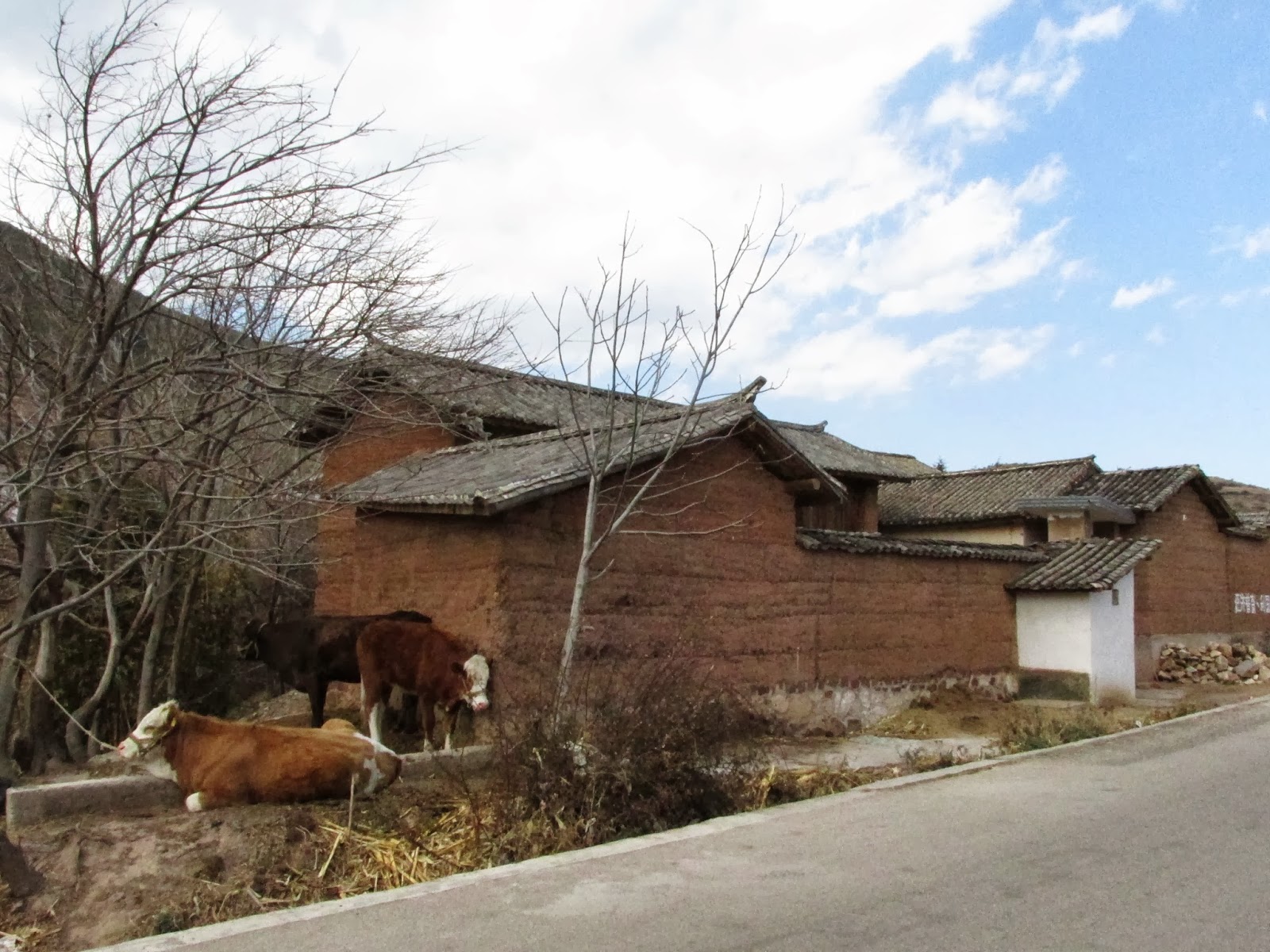After a
five hours riding on two buses, I arrived in Jianchuan. The bus from Dali was a
small one. My knees barely fit between the seats, but I was able to shift so
they didn’t press against the seat in front of me. The bus did not take the
highway; so the ride was not always smooth. The first two-thirds were fairly
flat and then the road went over the mountains. In Jianchuan, I found the van
to Shaxi. I was the first passenger. While waiting, I walked around to stretch
and then decided to buy some snacks for the rest of the trip. After I paid, the
man pointed to the van where a whole group of people were getting in. It was
full. I’d left my backpack on the seat to reserve it for me, but three girls
were sitting there. The driver indicated for me to get in on the other side. So
I did, and the three girls moved over. The road to Shaxi was rough. The vehicle
didn’t ride smoothly, and the road wove around as it went over the mountains.
The driver let me off at the intersection to the village where the guesthouse
is and pointed down the road and to the left. I decided that it wasn’t very
far; so I walked, which took about fifteen minutes. I enjoyed my first moments
walking in the countryside.
The
guesthouse is one I fell in love with when I first read about it. It’s in a
very small village about three kilometers from Shaxi, a larger village. It’s an
old theater—thus its name Old Theatre Inn—that has been restored and converted
to a guesthouse with only five rooms. It was very quiet while I was there, as
only two rooms were occupied. The woman at the desk, Sammy, speaks acceptable
English and, more importantly, tries to communicate and is very nice. Since
nights are cold and the walls are thin, the rooms have a portable heater and
the beds have electric blankets on the mattress. The electric blanket was
really nice, as the bed was where I spent the evenings. By the time I went to sleep,
the bed was toasty; so I could turn off the blanket and was cozy all night.
The
theatre has three levels.
The top level has an altar with a statue of a god.
There is a veranda outside the building that was wonderful for sitting and relaxing. Views of the fields are stunning even though it’s the winter season and most are brown.
There is a veranda outside the building that was wonderful for sitting and relaxing. Views of the fields are stunning even though it’s the winter season and most are brown.
I decided to walk to Sideng Square, the center of old Shaxi, to have some exercise and to enjoy being outside. The dirt road goes along the river. The second half of the river walk is beautiful. Unfortunately, there’s a lot of trash along the shore for most of the first half. This area—and the mountain I walked up—are the places with the most trash on the ground I have seen.
Shaxi
is an authentic village where people live and work. Very few buildings have
been reconstructed, and homes are modest.
The square is small and compact. It
has an old theater and temple, a few cafes, a few shops, and a guesthouse. The
theater is now a museum. Like the Old Theatre Inn, its top floor has an altar
with a statue of a god.
Walking back to the guesthouse with the evening sun illuminating
the fields was especially beautiful. Goats are raised and taken to the fields
to graze.
Tuesday
morning I planned to walk to an old temple on a nearby mountain. However, I
turned the wrong way and didn’t find the road leading to the trail. I asked
several people where it is, and two responded and pointed out the direction,
but I didn’t know the second word they were using. So I returned to the
guesthouse to get a bicycle for my new plan to have a bicycle ride. When I
mentioned that I’d walked to the Old Pear Temple, which is affiliated with the
guesthouse, Sammy showed me her key and offered to take me there. So we rode
there first so I could see the temple. I enjoyed the unique artwork on the
walls and the statues. It is being restored to be a community center and small school.
The book in my room says that it opened it April 2013; Sammy said it will be
finished this April. But I—and another guest I chatted with—think it will
probably be next year till it’s finished.
Then I
rode along the road. After Shaxi town, there wasn’t much traffic; so it was a
quiet ride. The road has several gentle hills that were easy to go up with the
24-speed bicycle.
My goal was to get to the river crossing, and an hour and a
half later I did.
On the way back, I walked into two of the roadside villages
to see what they are like. Houses aren’t fancy like those in Dali. Many don’t
have stucco covering the packed dirt, and they have outhouses on the outside of
the complex.
One path that looked interesting went to a small temple. New
construction is going up everywhere. The new houses are the modern style—bit
and fancy with indoor plumbing. (Again, I learned later that these are probably
vacation houses for wealthy people from elsewhere.)
I stopped
in old Shaxi to go to the temple and theatre, since they were closed Monday
evening when I was there. I planned to eat at one of the cafes, but it was
closed. So I went to a restaurant at a fancy guesthouse. It is a lovely old
house that has been converted. I ordered the local tuber dish. The tubers are
very thin and were fried; so they were crunchy. I could only eat half, but I
took the rest with me as snacks over the next couple days. Eating them was like
eating chips.
At the
guesthouse, I chatted with a woman I’d met briefly as I arrived. MaoMao is from
Sichuan but now works in Shanghai in real estate, helping people to purchase investment
property abroad and in China. In fact, she connected the American owner of the
guesthouse with the old theatre. This was her third time staying at the
guesthouse. She returned this time to bring her mother to the guesthouse and to
Shaxi.
Wednesday
I set off to go to the mountain again. This time I turned the correct way and
made the hike. The destination was Shizhong Temple, part of the complex of
grottoes on Shibao Mountain. The trail is paved with flat stones; so it is easy
to walk. I don’t know why I was surprised to see stone steps going up the
mountain, but I hadn’t thought about experiencing Chinese steps up a mountain
again.
The first part of the trail goes to two small temples built around carvings in the rocks. The second one is locked, but someone had removed one of the wooden bars so people can see and take photos easily.
After the second temple, the trail goes up to the top of the mountain. Part of it is lined with pine trees. After two hours, I arrived at a temple. From there, I could look down at a view of a large temple lower down, which I later learned is Shizhong Temple. There was a sign with a map of the Shibao Mountain area, but the symbol for “You are here” was missing; so I wasn’t sure exactly where I was.
The first part of the trail goes to two small temples built around carvings in the rocks. The second one is locked, but someone had removed one of the wooden bars so people can see and take photos easily.
After the second temple, the trail goes up to the top of the mountain. Part of it is lined with pine trees. After two hours, I arrived at a temple. From there, I could look down at a view of a large temple lower down, which I later learned is Shizhong Temple. There was a sign with a map of the Shibao Mountain area, but the symbol for “You are here” was missing; so I wasn’t sure exactly where I was.
Shizhong is the only temple in the area that is open to the public. (There are others on another mountain in the Shibao area.) It has a long area of Buddhist cave carvings. There are also two carvings of a famous king. A final carving is of female genitilia, the first I’ve seen that.
The weather was perfect for hiking—not too hot and not cold. A strong wind blew off and on throughout the day. My jacket and sweater were off and on all day, too.





















No comments:
Post a Comment